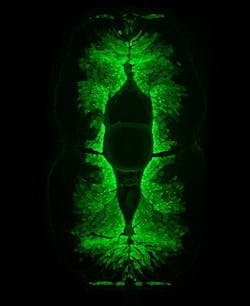New fluorescent protein from eel revolutionizes clinical biomarker
Researchers from the RIKEN Brain Science Institute (Wako City, Japan) have discovered that Unagi (Anguilla japonica), a Japanese freshwater eel, harbors a fluorescent protein that could serve as the basis for a new clinical test for bilirubin, a critical indicator of human liver function, hemolysis, and jaundice.1 The discovery also sheds light on the mysterious and endangered Unagi that could contribute to its conservation.
Related: Optogenetics shows that memories live in specific brain cells
Related: Chemical reagent, fluorescence microscopy team to produce mouse brain tissue details in 3-D
Drs. Atsushi Miyawaki and Akiko Kumagai and their team cloned a gene from Unagi for an unusual fluorescent protein they named UnaG, for Unagi Green protein, that allows eels to glow in the dark. UnaG is the first fluorescent protein found in vertebrates; previously, they were thought to exist only in simple animals like jellyfish.
But what makes UnaG truly unique in nature is that it needs a natural chemical to activate its powerful green light emission. In a surprise twist, the compound was identified by the authors to be bilirubin, a slippery molecule universally used in clinical labs around the world as a human blood marker for liver function.
Bilirubin is the breakdown product of blood hemoglobin and is toxic if present in excess in the body like in the characteristic yellow skin and eye color conditions seen in newborn babies, jaundice and kernicterus. It is also a common marker in blood tests where bilirubin is used by doctors to assess liver function and for the assessment of health, including hemolysis, the loss of red blood cells in anemia.
By analyzing the structure of UnaG, the team discovered a novel mechanism of fluorescence-enabling bilirubin to bind to UnaG and activate its light emission. With this property, they developed a superior new assay for bilirubin with high sensitivity, accuracy, and speed that may become the global clinical standard, and can be used in developing countries where child liver health is a major issue.
Japanese freshwater eels have a long-distance migration life cycle, growing in inland rivers and swimming far into the sea to spawn. The authors identified UnaG and bilirubin in the muscle cells of Japanese, American, and European eels where they may aid in endurance swimming during migration. The unexpected discovery of UnaG may initiate legislation to conserve endangered eel species.
âWe believe that UnaG provides an unexpected foothold into several important but currently obscure areas of human health including bilirubin metabolism and muscle physiology during endurance exercise,â Miyawaki concludes. âBefore the discovery of UnaG, I couldnât imagine that basic science could have such a direct impact on human health. From a simple eel, we found a new path to the clinic.â
REFERENCE
1. A. Kumagai et al., âA Bilirubin-Inducible Fluorescent Protein from Eel Muscle,â Cell, doi:10.1016/j.cell.2013.05.038 (2013).
-----
Follow us on Twitter, 'like' us on Facebook, and join our group on LinkedIn
Subscribe now to BioOptics World magazine; it's free!
